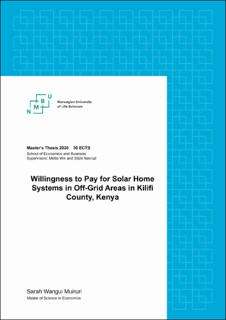| dc.description.abstract | The issue of energy access remains a concern in most countries, especially developing ones. This study aims to contribute to the demand dynamics of energy access by determining the willingness to pay and the factors affecting the willingness to pay for solar home systems (SHSs) among households living in off-grid areas in Kilifi County, Coastal Kenya. In the study I undertake a contingent valuation study that sees me collect data from 200 households. The study evaluates the willingness to pay for three different sizes of solar home systems by use of a payment card. The mean WTP is estimated using the payment card values, the interval midpoints and the unconditional interval regression. The mean WTP for system one, the smallest system, is KSh 793, Ksh 1155 and Ksh 1153 using the PC values, interval midpoint and unconditional interval regression, respectively. The mean WTP for system two, the medium system, is KSh 1228, Ksh 1658 and Ksh 1643 using the PC values, interval midpoint and unconditional interval regression, respectively. Finally, for system three, the largest system, the mean WTP is, KSh 1283, Ksh 1708 and Ksh 1706 using the PC values, interval midpoint and unconditional interval regression, respectively. Notably, households were willing to pay 7.84% of their income to pay for system 1, 11.25% for system 2 and 11.6% for system 3. I also estimate different regression models, namely, OLS, interval regression, tobit and logit models from the data. The income elasticity of WTP is observed to be increasing from the smallest and cheapest system to the more expensive systems, system two and three. When analysing the determinants of WTP levels, sex, income, and happiness are statistically significant for system one. Female headed households have a higher WTP for system one. Happiness shows a negative relationship with the WTP levels for system one. Income is the only statistically significant variable for system two whereas income and number of children are statistically significant for system three. There is a negative relationship between the number of children and WTP levels for system three. In all models, income has a positive significant relationship with WTP for system two and system three, and in most models for the smallest and cheapest system, system one. This conforms to economic theory. This study has itself captured the private benefits of SHSs in terms of the WTP levels of households, based on their income levels and income distribution. However, to determine if the government should offer subsidies to support the uptake of SHS in Kilifi County, a Cost Benefit Analysis (CBA) would need to be performed to compare the social benefits of SHSs, including external benefits, to the costs of SHSs. | en_US |

